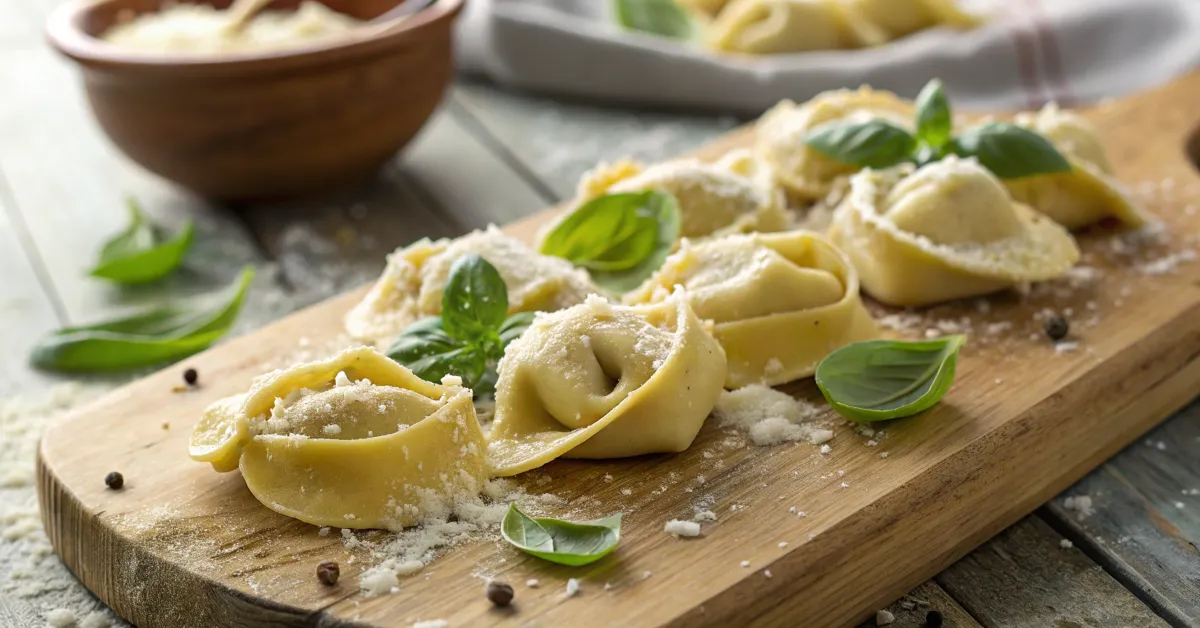Does tortellini have cheese in it? Tortellini is one of Italy’s most iconic dishes. Accordingly, this small, ring-shaped pasta is famous worldwide for its flavor and versatility. However, many people wonder: does tortellini always have cheese in it? The answer, therefore, depends on tradition, region, and personal taste. Historically, tortellini recipes often included cheese, though some regions opted for meat-based fillings. Moreover, modern variations have introduced ingredients such as vegetables, mushrooms, or even seafood.
In addition, while classic recipes remain popular, chefs and home cooks alike enjoy experimenting with new combinations. Furthermore, tortellini’s adaptability makes it suitable for countless dishes, ranging from brothy soups to rich cream sauces. Finally, in this article, we’ll explore its history, classic ingredients, modern variations, and how you can make it at home.
Table of contents
What Is Tortellini Made Of and Does It Include Cheese?
Tortellini is made with simple ingredients but delivers complex flavors. The dough is typically a mix of flour and eggs, rolled thin to create a soft, elastic base. The filling is where creativity shines. Cheese, meats, and vegetables are common. However, cheese-based fillings are the most traditional and widely loved.
Classic Cheese and Meat Fillings for Tortellini
Traditional tortellini often features cheese as a key ingredient. Specifically, ricotta and Parmesan are mixed with nutmeg to create a rich, creamy filling. Additionally, some regions add meat like pork or prosciutto for extra flavor. Furthermore, these fillings are usually paired with light sauces or served in broth to let the flavors stand out. Consequently, this approach highlights the delicate balance of ingredients while preserving the dish’s authenticity.
Modern Fillings
Today, cooks experiment with a variety of fillings. Vegetarian options, such as spinach, mushrooms, or butternut squash, are becoming more popular. Chefs also use seafood, like shrimp or lobster, to give tortellini a luxurious twist. Cheese fillings now include options like mozzarella or blue cheese for a richer taste.
If you want ideas for pairing cheese with other ingredients, check out what does cottage cheese go well with. This guide offers inspiration to make your tortellini unique.
Essential Ingredients for Homemade Cheese Tortellini
Making tortellini at home is easier than you think. You only need a few basic ingredients, and you can customize the filling however you like. Here’s a simple list to get started:
| Ingredient | Amount | Notes |
|---|---|---|
| All-purpose flour | 2 cups | Semolina can be used for extra texture |
| Eggs | 3 large | Makes the dough rich and smooth |
| Ricotta cheese | 1 cup | Substitute with tofu for a non-dairy option |
| Parmesan cheese | ½ cup | Adds depth to the filling |
| Spinach | 1 cup | Optional for a vegetarian twist |
| Nutmeg | ¼ tsp | Enhances the cheese filling |

These ingredients are perfect for creating traditional tortellini or experimenting with new flavors.
How to Make Cheese Tortellini: Step-by-Step Guide
Making tortellini by hand takes a little time but is very rewarding. Here’s how you can do it:
Step 1: Prepare the Dough
Mix the flour and eggs in a bowl until combined. Knead the dough on a floured surface for 8-10 minutes until smooth. Cover the dough with a damp cloth and let it rest for 30 minutes. Resting makes the dough easier to roll out later.
Step 2: Create the Filling
While the dough rests, mix ricotta, Parmesan, and nutmeg in a bowl. Add finely chopped spinach if you like. If you prefer meat, ground pork or chicken works well. Season with salt and pepper to taste.
Step 3: Roll and Cut the Dough
Divide the dough into small portions. Then, roll each portion into a thin sheet, about 1/16 inch thick. Next, use a knife or pastry cutter to cut the sheet into 2-inch squares. Additionally, ensure the cuts are precise to maintain uniformity in the pasta.
Step 4: Fill and Shape the Tortellini
Place a small spoonful of filling in the center of each square. Then, fold the square into a triangle and press the edges to seal. Next, bring the two corners of the triangle together and pinch to form a ring. Finally, repeat the process with the remaining dough and filling. Additionally, ensure each piece is sealed tightly to prevent leaks during cooking.

Pro Tips for Success
- Use just enough filling to avoid overstuffing.
- Seal the edges tightly to prevent leaks during cooking.
For additional tips on avoiding common mistakes, visit how to cook frozen soup dumplings. Many of these tips apply to making tortellini.
Exploring Cheese Tortellini Fillings in Depth
Cheese-Centric Fillings for Tortellini Lovers
Cheese-based fillings are the most popular. Ricotta and Parmesan are traditional choices, but mozzarella adds a creamy twist. For a bold flavor, try Gorgonzola or goat cheese. These fillings pair well with light butter or olive oil sauces.
Vegetarian Options
Spinach and ricotta are classic vegetarian fillings. Additionally, for a seasonal touch, roasted pumpkin or squash adds sweetness and depth. Moreover, mushrooms, sautéed with garlic and herbs, create a savory, earthy option. Consequently, these variations offer versatility and appeal to a wide range of tastes.
Meat and Seafood Fillings
Meat-filled tortellini often features pork, beef, or chicken seasoned with Italian spices. Additionally, for a special occasion, consider seafood fillings like crab or lobster. Furthermore, these fillings work well with cream-based sauces for an indulgent meal. Consequently, they provide a rich and elegant dining experience.
Frozen vs. Fresh Tortellini
Fresh tortellini is unmatched in flavor and texture, but frozen tortellini is a great option for busy days. Let’s compare the two:
- Frozen Tortellini: Convenient and quick to prepare. It’s pre-filled, often with cheese or meat, and cooks in minutes. Perfect for last-minute meals.
- Fresh Tortellini: Takes more time to prepare but tastes fresher. It allows you to experiment with fillings and sauces. Ideal for special dinners.
Making fresh tortellini at home is a fun and creative process. You can adjust the flavors to match your preferences and make the dish truly your own.
Pro Tips for Perfect Cheese Tortellini
Tortellini may seem simple, but a few key techniques can elevate it to perfection. These tips cover every stage of preparation, from rolling the dough to serving the final dish.
Dough Tips
- Roll evenly: Make sure the dough is uniformly thin to avoid uneven cooking. A pasta machine can help if you’re not confident rolling by hand.
- Rest and relax: Resting the dough for 30 minutes is essential. It relaxes the gluten, making the dough easier to work with.
- Keep it moist: Cover the dough with a damp cloth while working to prevent it from drying out.
Filling Tips
- Consistency is key: The filling should be thick enough to hold its shape. If it’s too runny, add breadcrumbs or grated cheese to firm it up.
- Mix thoroughly: Blend all filling ingredients evenly to ensure consistent flavor in every bite.
- Taste before filling: Always taste the filling and adjust the seasoning before assembling the tortellini.
Cooking Tips
- Use enough water: Tortellini needs space to cook evenly. Use a large pot with plenty of water.
- Don’t overcrowd: Cook in small batches to prevent the pasta from sticking together.
- Test for doneness: Fresh tortellini cooks quickly. Check frequently and remove as soon as they float.

Serving Suggestions and Creative Tortellini Variations with Cheese
Tortellini is incredibly versatile, making it a great option for various dishes. From classic pairings to modern twists, the possibilities are endless.
Traditional Serving Styles
- Brodo (broth): This comforting option highlights the flavors of traditional tortellini. Use a light chicken or vegetable broth to keep it simple and authentic.
- Butter and sage: Toss cooked tortellini in melted butter and add crispy sage leaves. Sprinkle with Parmesan for extra flavor.
Modern Twists
- Rich sauces: Cheese-filled tortellini pairs beautifully with creamy Alfredo or garlic-infused cream sauce.
- Hearty tomato sauces: For a robust meal, serve tortellini with marinara or Bolognese sauce.
- Chilled tortellini salads: Combine cooked, chilled tortellini with cherry tomatoes, fresh basil, olives, and a zesty vinaigrette.
Seasonal Variations
- Fall flavors: Add roasted pumpkin or butternut squash to the filling for a seasonal twist. Serve with browned butter and sage for an earthy, autumnal dish.
- Spring ingredients: Use fresh peas or asparagus in the filling, and pair with a light lemon butter sauce.
Creative Pairings
For an adventurous take, incorporate elements from the blueberry bagel recipe to experiment with sweet-savory contrasts. Similarly, the pumpkin bagels recipe offers inspiration for combining sweet and savory flavors.

FAQs: Everything About Tortellini and Cheese Fillings
Does tortellini have cheese inside?
Yes, cheese is one of the most common fillings for tortellini. Traditional recipes often feature ricotta, mixed with Parmesan or other cheeses, and seasoned with nutmeg. However, some variations use meat or vegetables instead of cheese.
What is tortellini made of?
Tortellini is made from pasta dough, typically a mixture of flour and eggs. The filling can vary and often includes cheese, meat, or vegetables. Its distinct ring shape is what sets it apart from other pastas.
What kind of cheese is in frozen tortellini?
Frozen tortellini usually contains ricotta or a combination of cheeses like ricotta, mozzarella, and Parmesan. These fillings are designed to appeal to a wide range of tastes.
Do all ravioli have cheese?
Not all ravioli have cheese. While cheese is a popular filling, ravioli can also be filled with ingredients like ground meat, spinach, mushrooms, or seafood.
What are the best sauces for tortellini?
Tortellini pairs well with simple sauces like butter and sage, light tomato-based sauces, and creamy options like Alfredo or garlic-infused cream.
How should I store leftover tortellini?
Cooked tortellini can be stored in an airtight container in the refrigerator for up to three days. To store uncooked tortellini, freeze them in a single layer on a tray before transferring to a freezer-safe bag.
Can I freeze homemade tortellini?
Yes, freezing tortellini is a great way to preserve them. Arrange uncooked tortellini on a baking sheet in a single layer, freeze until solid, and then transfer them to a freezer bag for long-term storage.
What is the difference between tortellini and tortelloni?
Tortellini is larger and often has lighter fillings like spinach and ricotta, while tortellini is smaller and can include heartier fillings like meat.

Conclusion
Tortellini is a pasta that perfectly balances tradition and creativity. Additionally, its versatility allows it to be served in countless ways, from a simple broth to a rich Alfredo sauce. Moreover, by making tortellini at home, you can experiment with different fillings and create a dish tailored to your preferences. Whether you stick to the classics or try something new, tortellini never fails to delight (as detailed in its history and variations). Finally, make it your own and enjoy every bite with satisfaction.

